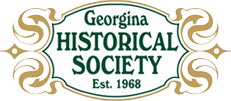Click to Download the PDF
Download the Word Doc
President’s Message
Welcome to the November edition of the Georgina Historical Society Newsletter. The year seems to have gone by quickly and once again it is time for our Annual meeting on November 17. The Annual meeting will be held at the Sutton Legion, meet and greet at 5:30, dinner at 6:pm. Although it is too late to reserve for the dinner since the Legion needed numbers by November 3 you are still welcome to attend the meeting and hear the guest speaker later in the evening.
Christmas in the Village will be on November 26, with the buildings open 3:00 pm until 5:30 pm .
The lighting of Christmas lights at the Civic Centre will be at 6:00 pm. If you are looking for something to do on December 03, you might wish to attend the Old Fashioned Christmas Craft Show at the Newmarket Community Centre 10:00 am until 4:pm featuring over 70 local crafters and artisans.
Looking forward to seeing you at these upcoming events
As my term as GHS president is ending, I wish to extend a big thank you for all your ongoing support during the past 5 years. Thank you! I have certainly enjoyed the opportunity to contribute to such a fine organization as the Georgina Historical Society.
Take Care! Stay safe!
Lest We Forget – By Tom Glover
On Remembrance Day our one room school house would hold a special afternoon program to honour the soldiers who served in WW1 and WW2. A local veteran, Bert Stephens would always take time from his busy farm schedule to come and distribute poppies. We would bring our nickels, dimes and pennies to donate to the Legion Poppy Fund. Our roll call for the meeting would be a name of a soldier who had served in one of the wars. This is where I first heard the names of the local men and women who served in WW1 and WW2.
My parents told me of the good and the bad results of the war on our family. While serving in the army, my mother’s younger brother Tommy met a girl, Isabel from BC and they fell in love and were married. Her sister Ruth’s fiancé, Willard was killed in a plane crash while training a novice pilot. My father’s cousin, Joe died on the beaches of Dieppe, one of the many casualties of that ill-fated action. His cousin Frank, boxing champion of the Canadian Armed Forces was awarded a medal for his valiant actions as a tank commander on the Gothic Line.
Growing up I learned more about neighbours who served in the war. Men like Cliff, a young man who died fighting for his country and who my mother when asked, remembered him with a smile and the response “He liked to dance with me”
Jim, a tail gunner who told me of flying many bombing missions and being so uptight he would be sick to his stomach before and upon returning from the mission. John, a spitfire pilot, who would believe this gentle, good natured man piloted a fighter plane and yet there in the farm kitchen hung a picture of a fierce young pilot and his plane. The Bosworth, Stephens, Mahoney, Barker, Martin, Pollock families, to name just a few, all saw young family members off to war. Unfortunately, not all returned. The war touched many lifes.
I think even more families had been affected by WW1, “The War to End All Wars”.
Patriotic duty and the desire for adventure led many young men to join up. My family are good examples of how the war touched the community. Typical of the young men, my grandfather’s brother, an engineer had been surveying in northern BC when the war began. On returning to Vancouver he was shocked to hear that Canada had been at war for 6 months. He was afraid the war would be over before he had a chance to serve on the front lines and signed up as soon as he could. Serving with the Third Tunneling Corps, in France, he survived the war only to die in a London hospital from appendicitis while awaiting orders to disembark for home.
As well as his brother, grandfather Glover had six cousins who served in WW1. They left their families and their jobs as farmers, masons, seeds men and river drivers to serve King and Country. One whose son had joined up in the spring of 1916 and at 54 being too old himself to be accepted into the forces lied about his age and joined in the summer of the same year. The son, George brought home an English bride and a baby when he returned from the war. The father was not so fortunate, trench warfare took a heavy toll on his body and he returned to his home in Canada in ill health and passed away soon thereafter. A Military Medal was brought home to Ravenshoe by cousin Les. A medal received for “good work on the line” at Villes Bretoneux in March 1918. He placed it in a drawer and never spoke about the medal or the war.
The impact of the war was similar to other families in the Ravenshoe community.
When a young man was about to leave for overseas, family, friends and neighbours would gather to bid him farewell. There would be food, entertainment and speeches to honour the brave recruit. The young man would be presented with a bible as a token of friendship and a reminder of his duty to God and fellow man and with wishes for a safe return.
Aunt Flo kept a scrapbook throughout the wars duration. Clippings of events from the newspapers, poems and stories from the front lines, postcards and notes from relatives, all found their way into her scrapbook. An original clipping of “Flanders Fields” by McCrae was one special entry and other poems were copied by hand because they meant so much to her. Among her last entries were a copy of the order to cease hostilities published in the Toronto Star and her brother Frank’s obituary from the Newmarket Era, April 1919 . A family ready to celebrate his home coming, now were to mourn his death; a cruel blow from the hand of fate.
The war was hard for the soldiers on the front lines but just as difficult for their families at home awaiting their safe return.
I learned an interesting lesson about life growing up in the small, rural, post war community of Ravenshoe. Among the neighbours and family who fought in the war or lost family members in the conflict were new Canadians of German, Italian, Polish and Dutch descent, who also fought for their countries in the war. They all lived side by side in harmony and no one seemed to hold grudges for the past conflicts. They helped each other with the threshing, loaned machinery and were always ready to lend a helping hand in emergencies. Children attended school, played together and became friends without any thought of nationality. My school mates and I learned at a young age that we were all the same, no matter what our race, religion or nationality.
Canada, a welcoming home to all; that’s a fact we would do well to remember today.
Editor’s note: Everyone was touched in some way by each of those wars. My Grandfather Herbert Scarborough saw duty as a medical sergeant on the front lines in WW1 and suffered from respiratory issues the rest of his life as a result of the gas attacks by the Germans. My Uncle Bob Scarborough was on the beach at D day as his brother, my Uncle Ted, watched the invasion unfold from the deck of his assignment upon a naval warship as the landings were made along the coast of France. Fortunately for the family, they both returned safe and sound to us. My Uncle Fred Holden was an officer on a Canadian warship doing dangerous convoy duty while my father was involved in some secret work with asdic in the Royal Canadian Navy, called sonar today and used for anti-submarine detection, which had been invented at the end of WW1 and only put into use by the British Navy in the 1920s. We learned later, long after WW2 was over, that he’d been engaged in supervising asdic installations at HMCS Naden in Esquimalt BC, and HMCS Cornwallis in Halifax. We were lucky enough to see him a couple of times during the war as he transited from one coast to the other. Other families were not so fortunate. One more thing, none of them ever spoke freely about their experiences in these wars
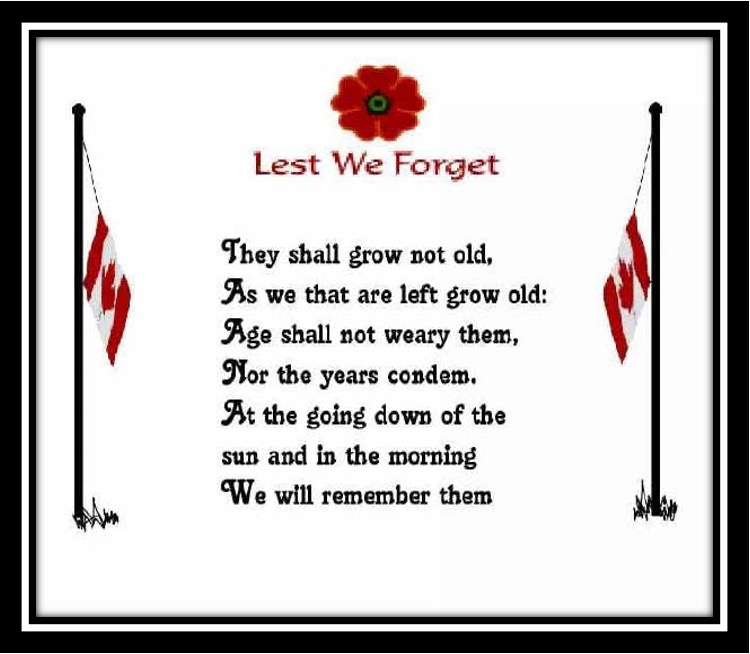
Memories of My First Job in Sutton – By Hessel Pape
To some of us the fifties do not seem to be that long ago, but in retrospect some seventy years have lapsed since, and they are rapidly becoming history. Those were the days when we filled up our car with gasoline at the BP on the corner of Dalton Road for 35¢ a gallon and we were served at the pump by a fellow who took our change and cleaned our windshield. Harry’s Snack Bar on High Street served milkshakes for a quarter and a chocolate bar was 10¢.Very few homes, if any, owned a freezer -we still had an icebox in our kitchen -and frozen vegetables and meats were kept at the local “lockers”.

In Sutton, Simcoe Lockers owned by Stuart McKie, was the cement block building on the north side of the Base Line, just past where the railway track to the Sutton Station went past Sutton Lumber and crossed the road. Actually, the building still exists there, though somewhat altered. In those days the upstairs was an attic used for storage. How I ended up late in the fall of 1954 working there after school and on Saturdays, I have quite forgotten. It may have been my father who told me to go and see Mr. McKie, who was looking to replace the young fellow, Allan Barber, who, a few years my senior, had decided to quit school and go elsewhere to seek his fortune. I was to be paid agenerous35¢ per hour, not bad for a teenager entering grade ten. It was quite common for a high school student to be paid considerably less than an unskilled adult labourer who was paid one dollar an hour in those days.
Like the exterior, the building was not very attractive. The back half was a large insulated room, kept well below freezing, and occupied by several rows of wooden lockers, somewhat like the ones we had in the change room at school, only these were all individually and securely locked and used to keep frozen meat and vegetables instead of our street clothes when we had gym. Each one was rented out to a customer who collected the appropriate key at the front counter. Our locker was #214, on the right hand side in the second alley. We did not keep any frozen meat in there, but vegetables for the winter which our mother had grown in the garden.
The front half of the ground floor was occupied by a store front of sorts, but never very busy since there was little if any merchandise for sale. At the back wall, on top of a cement platform, stood two gigantic compressors, which often as a result of a slight leak would smell of ammonia, the cooling agent used to keep the back room below freezing.
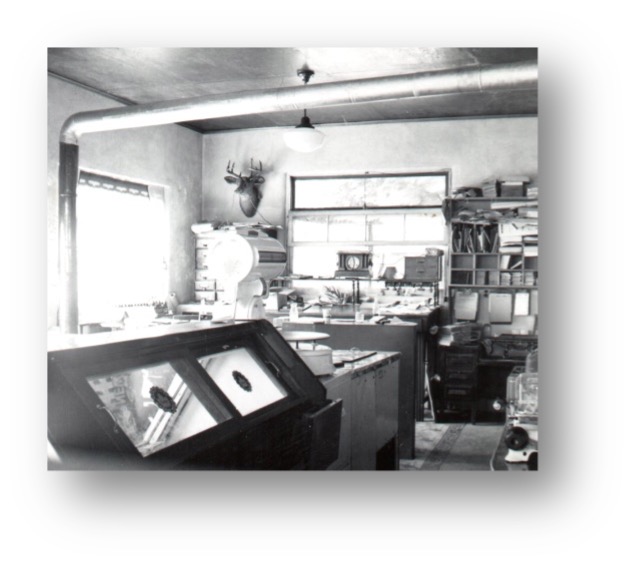
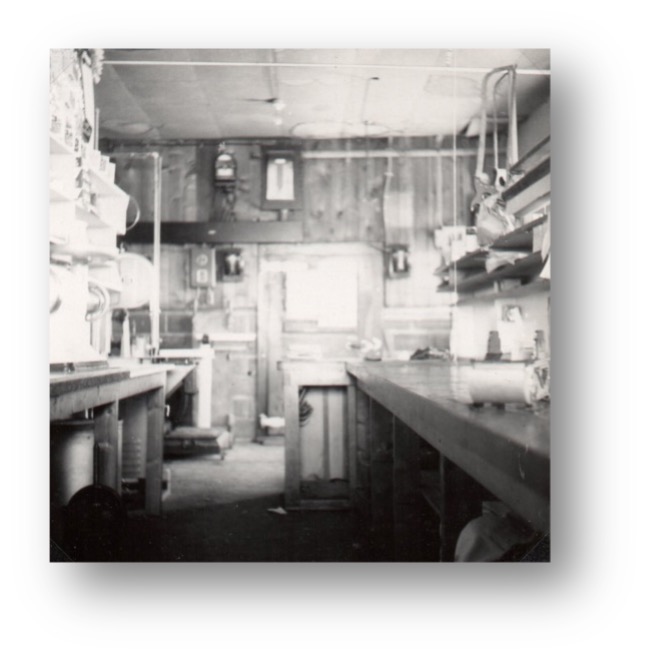
Along the right hand side of the front section was the meat cutting facility, complete with the counters, the heavy chopping block, the stainless meat cutting band saw, the meat grinder, and a sausage press that stood on the counter by the wall. You could not say that it was a butcher shop, but more of a “meat cutting” operation.
Farmers brought in their slaughtered life stock, generally in the fall, to be chopped up into steaks, roast, ground meat and soup bones, all to be wrapped in brown waxed paper, bound up with a string that hung down from the ceiling in a ball. The resulting parcels were fast-frozen and put into the client’s locker. They might bring in a calf, raised for slaughter, a hog, chickens, a turkey for Thanksgiving or Christmas, and towards the end of the hunting season, a deer or two. It was just the chickens I disliked doing. They came in plucked, but they had to be “drawn”, a process whereby you forced your hand up its rear end and “drew out” its guts. The giblets where sorted out and put back in before wrapping and freezing. Several well-to-do Suttonarians, the ones who lived in Wood River Acres, ordered a front or hind of beef, or sometimes a whole side, which we got from Canada Packers. After hanging in the cool room for a week to “age”- it was thought it would make the meat tenderer – we would then cut it up according to the directions of the customer. Buying a winter supply of meat in this way was somewhat more economical than shopping weekly at Styles Butcher Shop on the main street down town.
I remember one hot and sticky Saturday afternoon, when we had to work late to finish orders for our customers that Stu decided we would clean up on Monday morning. What we found was the waste tray in the bottom of the band saw crawling with an incredible mass of maggots, feasting lavishly to pupate and turn into thousands of flies. Outside we put an end to them in our incinerator, the large steel barrel that was used to get rid of meat wastes and the like. It used to smoke terribly and smell worse.
Canada Packers also supplied us with cases of frozen fruit that came in small packages, fruit such as strawberries, cherries, and the like to supply local hotels and summer resorts, but they sat around so long that they had to be chopped out of the ice and frost. I do not recall ever delivering such items. In the end much of it had to be thrown out.
The cases of hot dog wieners, also supplied by Canada Packers, fared better. I made regular deliveries to the Port Bolster Drive-in. When Ceril Scott, the drive-in owner, came in to place his order, he would often remind me to deliver the wieners at dusk on those summer evenings, and stay to watch the movies.
During that first summer at the Lockers, I made such deliveries driving a small Ford Thames truck, a tiny panel truck with rear doors for loading. I was sixteen by then, but had received a special drivers’ licence earlier that previous fall. Mr. Parks, who owned a wool shop, operated by his wife on High Street in Town, was the examiner. The main street was angle parking in those days. He had me back up out of the spot in front of his store, drive around Market Street, turn right again on High Street, and pull in to the still vacant parking spot once more.
“Do you know all your road signs?” he asked.
“Yes sir.”
“Okay. Come on in and I’ll get you your licence.”
That was all there was to it. I was fifteen and I had my drivers’ licence. The other successful account that Stuart McKie had been able to establish and maintain was with Findlay’s Dairy who delivered regularly out of Toronto.
They supplied us with bulk ice cream in tubs with which we, in turn, filled orders from hotels and summer camps in the area. With the little truck I made frequent deliveries at the Four Seasons Hotel, the Nazerine camp on the way to Pefferlaw, and the Estonian Camp as far away as Udora, besides a number of other smaller accounts along the Lake. We had two or three heavy brown canvas insulated bags that each held a couple of tubs of ice-cream. The latter came in just a few flavours back then, vanilla, strawberry, and chocolate, and if available, cherry vanilla and butterscotch ripple. On the odd occasion the driver from Toronto turned out to be the plant manager himself, Duncan Coombs.
He told me one day, “If you ever move to the city, come and see me for a job at the ice-cream plant. Stuart tells me you are a good worker.” Some years later, when I finished grade thirteen, I actually did so; I went to see him, got the job, and rented a room in the vicinity.
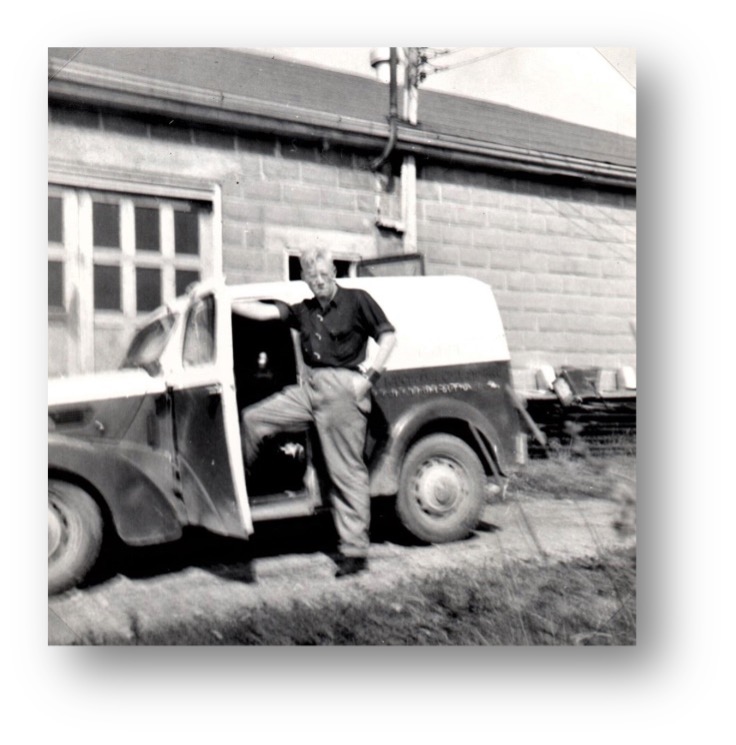
Later in the fall of 1956, I found the door locked and a notice on the front door. The sherif had visited and installed a heavy chain and padlock on the door. The place was closed, and the job had come to an end. Unfortunately I had a number of personal possessions inside, including my radio with the LP record player – we in effect had no hydro at home, so I had it set up at the lockers-as well as a version of the first tube radio ever sold publicly and therefore a valuable antique. I never did rescue them since as a sixteen year old I had no idea about how to deal with rules of the adult world; nor did my father, who suggested that I should go and see Stuart McKie at his home on River Street. I found him in his bed among blood stained sheets with an empty whiskey bottle in his hand. His wife had left him some weeks earlier.
“I need a drink,” he pleaded and spit up more blood from a bleeding stomach ulcer. “See if you can get me a bottle. Ask your father. I have no money to give you now, but I will payback later when I can.”
All I could do was to bring a report to my father at the carpentry shop, who knew him well enough since his woodworking machines had originally come from Stu. What happened after that to Stuart McKie, or the Lockers, I never got to know. It was adult business.
Editor’s Note: This story reminds me of an annual family ritual that took place for several years when my Dad and I would go to a farmer friend near Pakenham in Eastern Ontario. The farmer shot a beef for us to be split with my Uncle Ralph in Toronto. Dad and I would then skin it, and then after wrapping it into the hide, took it to the local Co-op in Renfrew where we lived at that time. There it was cut up and packaged as roasts, steaks, and other cuts then frozen for our eventual use This might be one good way to beat the horrible inflation of food prices today!
Our Pioneer Ancestors
MARK KAY, lot 7, concession 6, is the son of Joseph Kay, who emigrated from near Hull, Yorkshire, England, in 1829. Mr. Kay, senior, married in England, his family consisted of fourteen children, twelve of whom are still living. On his arrival in York County he settled in Georgina Township, and had in the early days to go all the way to Holland Landing to the nearest grist-mill.*
*Excerpted from: History of Toronto and County of York, Volume II; C. Blackett Robinson, Publisher 1885, p. 510.
Where in Georgina?
Can you identify the location and name of the mystery location below?
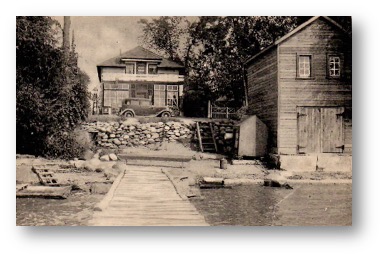
News
Your Board had a brief tour of the rebuilt school house in the Pioneer Village. It is almost ready for use with the ramp and entry completed and in place. The heating and lighting work well; all it needs now is an inspection by the Town’s Building and Fire Departments. Hopefully that will happen in time for the Old-fashioned Christmas on Saturday, November 26th. It should definitely be ready for use by next spring.
In our Annual Meeting in November we will be holding our annual election of officers for your Board. Nominations will be put forward for a new President and Vice-President and there will be openings on the Board for two new Directors. If you are interested in a more active role in the Georgina Historical Society or know of someone you know that would like to contribute by serving on the Board please contact Tom Glover at btglover@rogers.com or Paul Brady at pkbrady@rogers.com.

Events
November 17th – GHS member and art historian, Ewa Chwojko, will hold the last of a series of Art Talks; from noon to 2 PM at Bold Steps Dance Studio, 21100 Dalton Road, Jacksons Point. Cost $15 per session…see https://artamica.com/ for details.
November 17th – Thursday Annual Meeting of the Georgina Historical Society at the Sutton Legion, greet and meet from 5:30 followed by dinner at 6:15 pm, followed by elections and a guest speaker. A roast beef dinner will be served; tickets for the dinner are $25 each. Those who wish to attend after the dinner for only the meeting should be there no later than 7:15. Guest speaker will be Karen Wolfe to talk about Pefferlaw.
November 26th – Saturday, Old Fashioned-Christmas at Georgina Pioneer Village If you can help or volunteer and would like more information, please contact Melissa Matt, Curator of Georgina Pioneer Village, at 905-476-4301 ext. 2284 or curator@georgina.ca.
